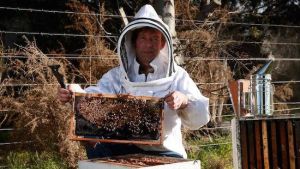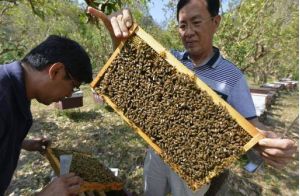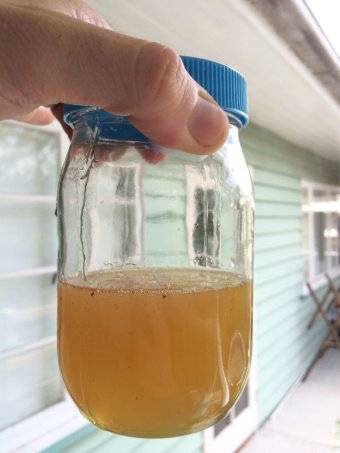Indigenous Australians have been harvesting food from the bush for thousands of years, and sugarbag honey from native Australian bees is a popular form of bush tucker.
Like European bees, sugarbag bees live in colonies and produce honey from nectar.

PHOTO: You can find stingless bee hives by looking for holes in hollow trees. (Supplied: Tobias Smith)
But unlike their northern counterparts, Australian native bees are stingless, making harvesting simple for the well-trained eye.
Peter Parlow is a Waanyi Garawa man living in Camooweal in remote north-west Queensland, 190km north-west of Mount Isa.
Mr Parlow is a bush tucker and medicine man, and knows what to look for when hunting for sugarbags.
"We look for a hollow tree and if you see a bee coming out, then you've got your sugarbag," he said
Stingless bees are often mistaken for flies because they are mostly black and similar in size.
"But you don't have many flies coming out of trees," Mr Parlow said.
"So, if you think you see [a fly coming out of a tree], that's a sugarbag bee."

PHOTO: Waanyi Garawa man Peter Parlow says knowledge of how to hunt for sugarbags is passed down verbally from generation to generation. (ABC North West Queensland: Zara Margolis)
Once a sugarbag hive has been located, it is important to slice down the trunk rather than across it.
"If you cut him right, it won't spill out," Mr Parlow said.
"You can eat it straight from the tree, or use it to make yellow cordial or have it on toast."
Honey has similar properties to manuka
Bee researcher Tobias Smith said there were about 600 species of stingless bees globally, and 11 in Australia.
"There are two groups of stingless bees in Australia — the tetragonula bees on the coast and the inland austroplebeia," he said.
"Stingless bees are found in a lot of tropical and sub-tropical parts of Australia [including] New South Wales, Queensland, the Northern Territory and Western Australia.
"They're generalist foragers and go to all sorts of different plants for pollen and nectar.
"With stingless bee [hives] there are no hexagonal combs, and [sugarbag honey] is not pale like with European honeybees. It's much darker and brown and rich."

PHOTO: Stingless bees (R) are often mistaken for flies due to their size and colouring. (Supplied: Tobias Smith)
Dr Smith said it was difficult to describe the taste of sugarbag honey.
"It varies quite widely. I would say no two hives are exactly the same, but it's always fantastic.
"Tetragonula bees, which are more coastal, store their honey in pots made of resin and wax, so you get the flavour of the resin … which is often a sharp citrus, tangy flavour.
"The austroplebeia bees make their honey pots more out of wax, which doesn't have a strong flavour, and their honey tastes more like the European honeybee."

PHOTO: Stingless bee honey is darker than honeybee honey, and can taste different depending on where the hive is grown. (Supplied: Tobias Smith)
Dr Smith said sugarbag honey also had medicinal qualities.
"We now know that stingless bee honey does have strong anti-microbial qualities, similar and in some cases much better than what we recognise in manuka honey.
"Trials haven't been done in human health yet, [but] if this work continues to be done we may well see medical industries jumping on stingless bee honey just as they've jumped on manuka honey."
Commercial plans
There is a growing commercial market for Australian stingless bee honey, according to Dr Smith.
"There's high demand for it, because not much of it is produced, and it attracts a high price when it is sold," he said.
"It ranges between about $150 and $250 a kilo."
But he said commercialisation was not without its challenges.
"If a European honeybee keeper has a good year, they might get 40 or 50 litres of honey from one hive … [but] with stingless bees they might get about 1 litre."

PHOTO: Dr Smith says a stingless bee hive will produce much less honey than a honeybee hive. (Supplied: Tobias Smith)
Unlike harvesting from a commercial or hobby hive, taking honey from a native sugarbag hive often means the entire colony is destroyed.
But Dr Smith said land clearing, rather than traditional hunting, was the biggest threat to native bee colonies.
He said sugarbag hunting had a minor impact on the overall population of Australian sugarbag bees and the skill should be preserved.
"What a shame it would be to stop having this practice, this culture, that's been going on for thousands of years and is probably one of the longest honey cultures of the world," he said.
http://www.abc.net.au/news/2018-01-21/native-honeybees-provide-popular-bush-tucker/9333278
First posted 21 Jan 2018, 6:11am





